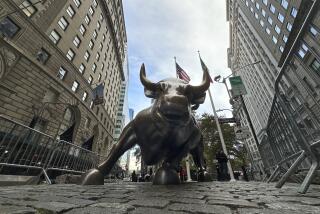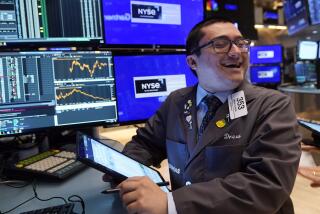Dollar Plunges; Markets Follow : Economy: Worldwide inflation worries and a surprise surge in the U.S. trade deficit are blamed for the currency’s fall. Another interest rate increase may result.
- Share via
WASHINGTON — Worldwide inflation jitters Tuesday sent the dollar plummeting against the yen and other foreign currencies, pounding the stock and bond markets and raising new fears of an interest rate hike that could threaten the nation’s economic recovery.
The dollar fell briefly below the once-unthinkable barrier of 100 yen, its decline hastened by new figures showing that the U.S. trade deficit surged an unexpected 22.1% in April to $8.4 billion. The Dow Jones Industrial Average lost 33.93 points, bringing the indicator’s six-day losses to 2.7%.
“It’s just a pervasive nervousness about developments all over the world, with inflation fears underlying it all,” said Robert D. Hormats, vice chairman of Goldman, Sachs International. “It’s worrisome because so much of the U.S. recovery has depended on low interest rates. And, if this raises rates for a sustained period, that will slow the recovery.”
The continued market turbulence generally mirrored declines in Europe and Asia and raised some expectation that central banks would begin buying up billions in dollars to reverse the slide. But for the moment, Clinton Administration officials only repeated their insistence that the economy’s condition does not justify the dollar’s fall and withheld action.
By raising fears of inflation, the fall also caused bond buyers to worry about erosion in the value of their investments. And the prospect of higher bond yields in turn led some stock investors to sell off their shares in expectations of higher yields in bonds.
“The markets are seeing weakness everywhere,” said Ian Spence, a senior currency trader with Chemical Bank in New York. “It’s just feeding on itself.”
Investors fear that inflation will trigger another round of interest rate hikes in the United States, slowing the economy and hurting investments in stocks and bonds. Many investors respond by moving their investments into foreign currencies, which drives down the value of the dollar against those currencies.
A secondary factor, some traders said, was investors’ lack of confidence that the Administration is up to the task of handling the political and economic problems it faces, from North Korea to Bosnia.
Inflation concerns recently have been fanned by signs that commodities--notably oil--are seeing worrisome price rises.
Although the Federal Reserve does not make it a practice to raise interest rates as a means of stabilizing the dollar, some economists said they believe that the Fed’s governors might want to offset an inflationary spiral caused by the falling dollar. A cheaper dollar raises the cost of imports for consumers.
Wayne D. Angell, chief economist at Bear Stearns & Co. and a former Fed governor, predicted that the Federal Reserve would raise rates July 5 at the next meeting of the Fed’s Open Market Committee.
At the same time, there have been signs that German interest rates might be rising. Lothar Klausing, an economist with the Dresdner Bank in Frankfurt, attributed the dollar’s continued weakness to expectations that German rates might soon increase, as well as to concerns over the U.S.-Japanese trade conflict and fears of inflation’s effects on U.S. bonds.
“There are inflation fears,” he said. “And people have no confidence as to U.S. interest rates.”
Still, Klausing and several U.S. analysts said the dollar’s fall might yet be an overreaction to an American economy that continues to display many signs of strength.
Foreign investors fear that a falling dollar will lead to higher interest rates because the Fed often uses interest rate increases to reverse such declines. The Fed does so because higher interest rates attract more foreign investors to U.S. currency, increasing the value of the dollar.
Spence, of Chemical Bank, said traders have expected to see central banks begin buying up currency in the past several days. “When they didn’t, that just added fuel to the fire,” he said.
On May 4, central banks intervened massively to try to stabilize the dollar in a move orchestrated by Treasury Secretary Lloyd Bentsen. Now, however, the Treasury Department apparently hopes that the dollar’s slide is nearing an end.
Hormats, of Goldman Sachs, said the dollar’s turbulence reflects in part the enormous growth of dollar holdings abroad. During the 1980s, about $170 billion flowed to foreign investors annually because of large trade deficits.
In this decade, those levels have been swollen by foreign direct investment and other factors, so the annual outflow now is closer to about $250 billion a year.
“And if foreigners start seeing that they can’t hold those dollars at a stable currency rate, they can get nervous--and start to sell,” Hormats said.
In addition to dipping below the 100-yen barrier, the dollar also dropped below the critical 1.60 level against the deutsche mark.
The dollar ended Tuesday at 100.35 yen, down from 101.90 on Monday. It was a postwar record closing low. The dollar also ended at 1.594 German marks, down from 1.60 and the lowest since May, 1993.
The benchmark 30-year bond yield rose to 7.49% from 7.46% on Monday. The last time the yield hit that level was May 13. The price of the bonds dropped 3/8, or $3.75 per $1,000 of face value.
The Dow’s fall marked its lowest close since May 9.
Times staff writer Marjorie Miller in Bonn contributed to this story.
Key Questions
Q: What is depressing the dollar?
A: Economists can’t find solid explanations. They are attributing the slide mainly to negative sentiment toward the U.S. currency in the global foreign-exchange market. Some say this reflects a lack of confidence in the Clinton Administration’s foreign policy, particularly negotiations with Japan over its trade surplus. Many money traders believe that Washington wants to keep the yen high, which in the long run should depress Japan’s exports by making them more expensive. Trade figures released Tuesday showed that the Japanese surplus with the United States remains huge, putting more downward pressure on the dollar.
Q: What does this mean for consumers?
A: Not very much, at least in the near term. Although the dollar’s purchasing power has weakened abroad, importers have so far been absorbing higher costs for cars, appliances and other items. But if the dollar continues to weaken over the next several months, prices for imports could rise and domestic manufacturers might opt to boost prices as well. That could fuel inflation. People traveling to Europe and Japan will find that they can’t buy as much with their dollars.
More to Read
Inside the business of entertainment
The Wide Shot brings you news, analysis and insights on everything from streaming wars to production — and what it all means for the future.
You may occasionally receive promotional content from the Los Angeles Times.











